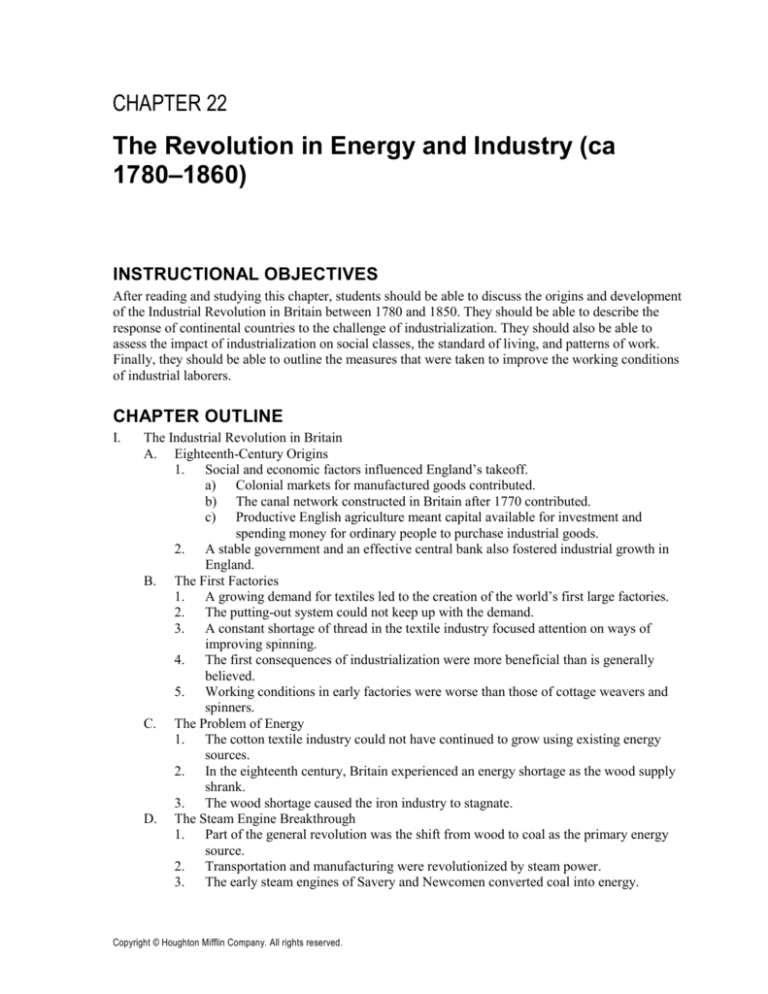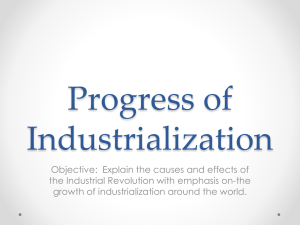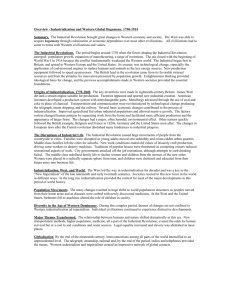
CHAPTER 22
The Revolution in Energy and Industry (ca
1780–1860)
INSTRUCTIONAL OBJECTIVES
After reading and studying this chapter, students should be able to discuss the origins and development
of the Industrial Revolution in Britain between 1780 and 1850. They should be able to describe the
response of continental countries to the challenge of industrialization. They should also be able to
assess the impact of industrialization on social classes, the standard of living, and patterns of work.
Finally, they should be able to outline the measures that were taken to improve the working conditions
of industrial laborers.
CHAPTER OUTLINE
I.
The Industrial Revolution in Britain
A. Eighteenth-Century Origins
1. Social and economic factors influenced England’s takeoff.
a) Colonial markets for manufactured goods contributed.
b) The canal network constructed in Britain after 1770 contributed.
c) Productive English agriculture meant capital available for investment and
spending money for ordinary people to purchase industrial goods.
2. A stable government and an effective central bank also fostered industrial growth in
England.
B. The First Factories
1. A growing demand for textiles led to the creation of the world’s first large factories.
2. The putting-out system could not keep up with the demand.
3. A constant shortage of thread in the textile industry focused attention on ways of
improving spinning.
4. The first consequences of industrialization were more beneficial than is generally
believed.
5. Working conditions in early factories were worse than those of cottage weavers and
spinners.
C. The Problem of Energy
1. The cotton textile industry could not have continued to grow using existing energy
sources.
2. In the eighteenth century, Britain experienced an energy shortage as the wood supply
shrank.
3. The wood shortage caused the iron industry to stagnate.
D. The Steam Engine Breakthrough
1. Part of the general revolution was the shift from wood to coal as the primary energy
source.
2. Transportation and manufacturing were revolutionized by steam power.
3. The early steam engines of Savery and Newcomen converted coal into energy.
Copyright © Houghton Mifflin Company. All rights reserved.
156
Chapter 22: The Revolution in Energy and Industry (ca 1780–1860)
4. James Watt increased the efficiency of the steam engine.
5. Steam power was used in many industries.
6. The use of steam power transformed the iron industry.
E. The Coming of the Railroads
1. Beginning in the 1830s, railroads transformed the economy, society, and culture.
2. Railroads reduced the cost and uncertainty of overland shipping.
3. The construction of railroads created demand for unskilled labor.
F. Industry and Population
1. In 1860, Britain produced 20 percent of the world’s industrial goods.
2. Increases in production led to increases in GDP and a population boom.
3. Industrialization and the growth of an urban working class led to the theories of
Malthus and Ricardo about the likely consequences of overpopulation and the likely
stagnation of workers’ standard of living (“the iron law of wages”).
II. Industrialization in Continental Europe
A. National Variations
1. There were several variations on the industrialization theme. Different countries
followed different routes.
2. Belgium and the United States followed Britain’s lead.
3. France showed only gradual growth in the early nineteenth century.
4. By 1913, Germany and the United States were challenging British leadership in
industrialization.
B. The Challenge of Industrialization
1. Continental countries had a number of disadvantages in industrialization.
a) The Napoleonic Wars had devastated the European continent.
b) It was difficult for continental manufacturers to compete with inexpensive
imported British goods.
c) As industrial enterprises grew larger, greater and greater investments were
required to set them up.
d) Continental workers lacked the technological skills British workers had
developed.
2. Continental countries also had advantages.
a) Most continental countries had a tradition of a successful putting-out system.
b) Continental countries could simply borrow advanced British technology.
c) Continental countries had strong independent governments.
C. Agents of Industrialization
1. British experts brought industrial secrets to the continent.
2. Talented entrepreneurs also served as agents of industrialization.
D. Government Support and Corporate Banking
1. Continental governments imposed tariffs to protect fledgling industries.
2. In Belgium, France, and Prussia the state provided important financial assistance to
industrialization.
3. German nationalist Friedrich List promoted economic nationalism, the idea that to
industrialize a country needed trade barriers to protect its manufacturers.
4. Changes in banking on the continent, such as the creation of limited liability
corporations, also facilitated industrialization.
III. Relations Between Capital and Labor
A. The New Class of Factory Owners
1. Early industrialists operated in a highly competitive environment.
2. Industrialists came from a variety of backgrounds.
3. Over time, entry into well-developed industries became more difficult.
4. Wives and daughters found it increasingly difficult to participate in the business world.
Copyright © Houghton Mifflin Company. All rights reserved.
Chapter 22: The Revolution in Energy and Industry (ca 1780–1860)
B.
C.
D.
E.
157
The New Factory Workers
1. Factory workers emerged as a new group in society.
2. Many writers portrayed the harsh working conditions for factory workers.
3. Engels lashed out at factory owners in his The Condition of the Working Class in
England (1844).
4. Ure and Chadwick argued that industrialization had improved the quality of life for
people.
5. Recent statistical studies suggest that workers’ standard of living began to rise after
1820.
Conditions of Work
1. Factory work meant more discipline and loss of personal freedom.
2. Child labor increased.
3. Children and parents worked long hours.
4. Family employment carried over into early factories.
5. Parliament sought to limit child labor (the Factory Act of 1833).
6. The new legislation broke the pattern of whole families working together.
7. Ties of blood and kinship remained important in labor patterns and conditions between
1790 and 1840.
The Sexual Division of Labor
1. A variety of factors contributed to the reorganization of work along gender lines.
2. Eventually, the Industrial Revolution strengthened the notion of a woman’s “separate
sphere,” as women increasingly stayed home to take care of the household while men
went to the factories.
3. The Mines Act of 1842 prohibited all women as well as boys under ten from working
underground.
The Early Labor Movement in Britain
1. Working-class solidarity developed in small workshops and large factories.
2. Poor working conditions, starvation wages, and the liberal capitalist legal attack on
artisan guilds led to the development of workers’ organizations (trade unions).
3. The next stage in the British trade union movement was the effort to create a single
national union.
4. British workers also engaged in direct political activity in defense of their own
interests.
LECTURE SUGGESTIONS
1.
“The Final Movement toward Industrial Capitalism.” What transformed European society in the
eighteenth century? What factors contributed to the making of an urban working class? Sources: J.
Rule, The Labouring Classes in Early Industrial England, 1750–1850 (1987); E. P. Thompson,
The Making of the English Working Class (1963); D. Bythell, The Handloom Weavers (1969).
2.
“The Evils of the Industrial Revolution.” What were the negative results of the Industrial
Revolution? How did the Industrial Revolution affect the lives of the working class? Sources: D.
Valenze, The First Industrial Woman (1995); P. Taylor, ed., The Industrial Revolution: Triumph
or Disaster? (1970); B. Harrison, Drink and the Victorians (1971); F. Engels, The Condition of
the Working Class in England (1845).
Copyright © Houghton Mifflin Company. All rights reserved.
158
Chapter 22: The Revolution in Energy and Industry (ca 1780–1860)
CLASSROOM ACTIVITIES
I.
Classroom Discussion Suggestions
A. What impact did the Industrial Revolution have on working-class women?
B. What role did children of the working class play in late eighteenth- and nineteenth-century
England?
C. To what extent were writers such as Dickens sensitive to the plight of the urban proletariat?
D. According to Engels, what was the condition of the working class in England?
II. Doing History
A. Have students read selections from the following sources and discuss their findings. The
discussion might lead to the writing of a short historiographical paper on the Industrial
Revolution. Sources: R. H. Hilton et al., The Transition from Feudalism to Capitalism
(1976); W. A. Hayek, ed., Capitalism and the Historians (1954).
B. If slides are available, give a slide presentation of some of the works of William Hogarth,
Gustave Doré, and Honoré Daumier. Have students discuss the emphasis of these works.
Were these painters sensitive to the plight of the urban proletariat, or did they merely
observe and record their impressions of an artistic subject?
C. Have students read selections from the following sources and write short papers on how
these works reflect the times. Sources: C. Dickens, Hard Times, Oliver Twist, A Christmas
Carol; A. Ure, The Philosophy of Manufacturers (1835); E. Gaskell, Mary Barton and North
and South; E. Zola, Germinal.
III. Cooperative Learning Activities
A. Charge six student teams with creating murals of their impressions of the Industrial
Revolution. After the murals are completed, have teams share them with the class,
explaining why they included certain features and images. Instructors may wish to display
murals on classroom walls.
B. Using the murals created in Activity A above, have each team write an essay describing the
various elements in their murals. Have a representative from each team read the team essay
to the class.
MAP ACTIVITY
1.
Have students shade in British cottage industries on an outline map of the United Kingdom.
2.
Have students list the major languages of Western Europe on a blank outline map of Europe.
3.
Map Activity: Using Map 22.1 (Cottage Industry and Transportation in Eighteenth-Century
England) as a reference, answer the following questions.
a.
How did the existing transportation infrastructure influence the geographical distribution of
industrial centers in England?
b.
How did a desire to promote the textile industry shape the development of England’s
transportation infrastructure between 1760 and 1800?
AUDIOVISUAL BIBLIOGRAPHY
1.
The Industrial Revolution in England. (26 min. Color. Encyclopedia Britannica Films.)
2.
The Industrial Revolution: Beginnings in the U.S. (23 min. Color. Encyclopedia Britannica Films.)
Copyright © Houghton Mifflin Company. All rights reserved.
Chapter 22: The Revolution in Energy and Industry (ca 1780–1860)
3.
159
Great Rivers of the World. (Videodisc. 5 discs, 40–50 min. ea. Films for the Humanities and
Sciences.)
a.
The Danube
b.
The Loire
c.
The Rhine
d.
The Thames
e.
The Volga
4.
City of the Big Shoulders. (Videodisc. 52 min. Color. Films for the Humanities and Sciences.)
5.
Crystal Palace: The Great Exhibition of 1851
(http://www.vanderbilt.edu/AnS/english/Clayton/318visual_1851.htm)
6.
The Newcomen Steam Engine
(http://www.technology.niagarac.on.ca/people/mcsele/newcomen.htm)
7.
Early Industrialization in Lowell, Massachusetts
(http://invention.smithsonian.org/centerpieces/whole_cloth/u2ei/u2intro.html)
INTERNET RESOURCES
1.
The Factory System: Early Production (http://www.cottontown.org/page.cfm?pageid=339)
2.
The Life the Industrial Worker in Nineteenth-Century England
(http://www.victorianweb.org/history/workers1.html)
3.
The 1833 Factory Act: Did It Solve the Problem of Children in Factories?
(http://www.learningcurve.gov.uk/snapshots/snapshot13/snapshot13.htm)
4.
The 1834 Poor Law: What Did People Think of the New Poor Law?
(http://www.learningcurve.gov.uk/snapshots/snapshot08/snapshot8.htm)
5.
The Workhouse (http://www.workhouses.org.uk/)
6.
The Industrial Revolution: Primary Sources
(www.fordham.edu/halsall/mod/modsbook14.html#The%20Industrial%20Revolution)
SUGGESTED READING
There is a vast and exciting literature on the Industrial Revolution. R. Cameron and L. Neal, A Concise
Economic History of the World, 4th ed. (2003), provides an introduction to the issues and has a
carefully annotated bibliography. J. Goodman and K. Honeyman, Gainful Pursuits: The Making of
Industrial Europe, 1600–1914 (1988) and S. Pollard, Peaceful Conquest: The Industrialization of
Europe (1981), are excellent general treatments of European industrial growth. These studies also
suggest the range of issues and interpretations. R. Sylla and G. Toniolo, eds., Patterns of European
Industrialization (1991), is an important collection by specialists. T. Kemp, Industrialization in Europe,
2d ed. (1985), is also useful. S. King and G. Timmins, Making Sense of the Industrial Revolution
(2001); P. Hudson, The Industrial Revolution (1992); and M. Berg, The Age of Manufactures: Industry,
Innovation and Work in Britain, 1700–1820 (1985), admirably discuss the various aspects of the British
breakthrough and offer good bibliographies, as does the work by Crafts mentioned in the Notes. E. A.
Wrigley, Continuity, Chance and Change: The Character of the Industrial Revolution in England
(1994), in an important reconsideratoin stressing resources and population. K. Pomeranz, The Great
Divergence: China, Europe, and the Making of the Modern World Economy (2000), is a sophisticated
Copyright © Houghton Mifflin Company. All rights reserved.
160
Chapter 22: The Revolution in Energy and Industry (ca 1780–1860)
reconsideration of why western Europe achieved this industrial breakthrough and China did not. P.
Sterns, The Industrial Revolution, 3d ed. (2007), is a useful brief survey.
W. Walton, France and the Crystal Palace: Bourgeois Taste and Artisan Manufacture in the 19th
Century (1992), and H. Kirsh, From Domestic Manufacturing to Industrial Revolution: The Case of the
Rhineland Textile Districts (1989), examine the gradual transformation of handicraft techniques and
their persistent importance in the international economy. A. S. Milward and S. B. Saul, The Economic
Development of Continental Europe, 1780–1870 (1973) and The Development of the Economies of
Continental Europe, 1850–1914 (1977), may be compared with J. Clapham’s old-fashioned classic,
Economic Development of France and Germany (1963). C. Heywood, The Economic Development of
France, 1750–1914 (1992), introduces the main issues and provides and up-to-date bibliography. Other
important works on industrial developments are G. Tortella, The Development of Modern Spain (2000)
and W. Blackwell, The Industrialization of Russia, 2d ed. (1982). M. Wintle, An Economic and Social
History of the Netherlands: Demographic, Economic and Social Transitions (2000), and L. Magnusson,
An Economic History of Sweden (2000), are excellent surveys of developments in two smaller
countries. L. Moch, Paths to the City: Regional Migration in Nineteenth-Century France (1983), and
W. Schivelbusch, Disenchanted Night: The Industrialization of Light in the Nineteenth Century (1983),
imaginatively analyze quite different aspects of industrialization’s many consequences.
The debate between “optimists” and “pessimists” about the consequences of industrialization in Britain
goes on. Two excellent studies with a gender perspective revitalize the debate: D. Valenze, The First
Industrial Woman (1995); P. Hudson and W. Lee, eds., Women’s Work and the Family Economy in
Historical Perspective (1990). R. Fuchs, Gender and Poverty in Nineteenth-Century Europe (2005),
provides broad comparative perspective. P. Taylor, ed., The Industrial Revolution: Triumph or
Disaster? (1970), is a useful introduction to older studies. It is also fascinating to compare Engels’s
classic condemnation, The Condition of the Working Class in England (1844), with Andrew Ure’s
optimistic defense, The Philosophy of Manufactures, first published in 1835 and often reprinted. J.
Rule, The Labouring Classes in Early Industrial England, 1750–1850 (1987), is a recommended
synthesis. E. P. Thompson continues and enriches the Engels’s tradition in The Making of the English
Working Class (1963), an exciting book rich in detail and early working-class lore. Pike’s documentary
collection, cited in the Notes, provides fascinating insights into the lives of working people, as does L.
Frader, The Industrial Revolution: A History in Documents (2005). Voth, cited in the Notes, is a
fundamental contribution. L. Davidoff and C. Hall, Family Fortunes: Men and Women of the English
Middle Class, 1750–1834 (2003), examines both economic activities and cultural beliefs with great
skill. D. Landes, Dynasties: Fortunes and Misfortunes of the World’s Great Family Businesses (2006),
and H. James, Family Capitalism: Wendels, Haniels, Falcks, and the Continental Model (2006), offer
fascinating and insightful histories of famous family enterprises and leading capitalists. D. Winch,
Riches and Poverty: An Intellectual History of Political Economy in Britain, 1750–1834 (1996),
provides an excellent survey of early English economists. F. Klingender, Art and the Industrial
Revolution, rev. ed. (1968), is justly famous, and M. Ignatieff, A Just Measure of Pain (1980), is an
engrossing study of prisons during British industrialization.
Among general studies, G. S. R. Kitson Clark, The Making of Victorian England (1967), is a
particularly imaginative. M. Bently, Politics Without Democracy, 1815–1914 (1984), is a fine general
history of Britain. B. Harrison skillfully illuminates the problem of heavy drinking in Drink and the
Victorians (1971). The most famous contemporary novel dealing with the new industrial society is
Charles Dickens’s Hard Times, an entertaining but exaggerated story. Mary Barton and North and
South by Elizabeth Gaskell are more realistic portrayals, and both are highly recommended.
Copyright © Houghton Mifflin Company. All rights reserved.









